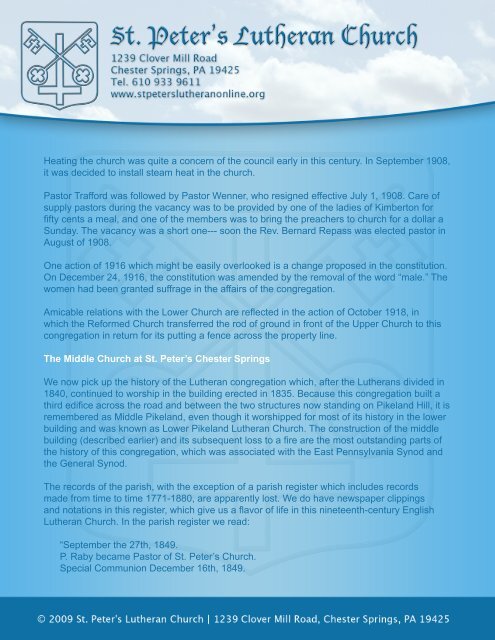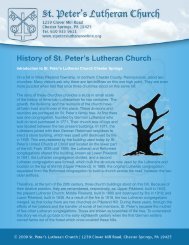History of St. Peter's Lutheran Church
History of St. Peter's Lutheran Church
History of St. Peter's Lutheran Church
You also want an ePaper? Increase the reach of your titles
YUMPU automatically turns print PDFs into web optimized ePapers that Google loves.
Heating the church was quite a concern <strong>of</strong> the council early in this century. In September 1908,<br />
it was decided to install steam heat in the church.<br />
Pastor Trafford was followed by Pastor Wenner, who resigned effective July 1, 1908. Care <strong>of</strong><br />
supply pastors during the vacancy was to be provided by one <strong>of</strong> the ladies <strong>of</strong> Kimberton for<br />
fifty cents a meal, and one <strong>of</strong> the members was to bring the preachers to church for a dollar a<br />
Sunday. The vacancy was a short one--- soon the Rev. Bernard Repass was elected pastor in<br />
August <strong>of</strong> 1908.<br />
One action <strong>of</strong> 1916 which might be easily overlooked is a change proposed in the constitution.<br />
On December 24, 1916, the constitution was amended by the removal <strong>of</strong> the word “male.” The<br />
women had been granted suffrage in the affairs <strong>of</strong> the congregation.<br />
Amicable relations with the Lower <strong>Church</strong> are reflected in the action <strong>of</strong> October 1918, in<br />
which the Reformed <strong>Church</strong> transferred the rod <strong>of</strong> ground in front <strong>of</strong> the Upper <strong>Church</strong> to this<br />
congregation in return for its putting a fence across the property line.<br />
The Middle <strong>Church</strong> at <strong>St</strong>. Peter’s Chester Springs<br />
We now pick up the history <strong>of</strong> the <strong>Lutheran</strong> congregation which, after the <strong>Lutheran</strong>s divided in<br />
1840, continued to worship in the building erected in 1835. Because this congregation built a<br />
third edifice across the road and between the two structures now standing on Pikeland Hill, it is<br />
remembered as Middle Pikeland, even though it worshipped for most <strong>of</strong> its history in the lower<br />
building and was known as Lower Pikeland <strong>Lutheran</strong> <strong>Church</strong>. The construction <strong>of</strong> the middle<br />
building (described earlier) and its subsequent loss to a fire are the most outstanding parts <strong>of</strong><br />
the history <strong>of</strong> this congregation, which was associated with the East Pennsylvania Synod and<br />
the General Synod.<br />
The records <strong>of</strong> the parish, with the exception <strong>of</strong> a parish register which includes records<br />
made from time to time 1771-1880, are apparently lost. We do have newspaper clippings<br />
and notations in this register, which give us a flavor <strong>of</strong> life in this nineteenth-century English<br />
<strong>Lutheran</strong> <strong>Church</strong>. In the parish register we read:<br />
“September the 27th, 1849.<br />
P. Raby became Pastor <strong>of</strong> <strong>St</strong>. Peter’s <strong>Church</strong>.<br />
Special Communion December 16th, 1849.




